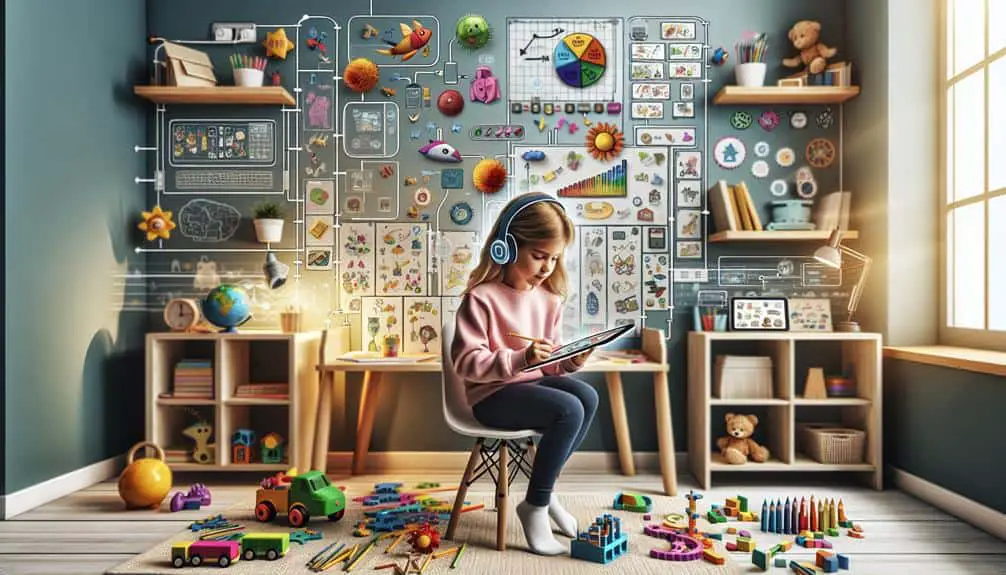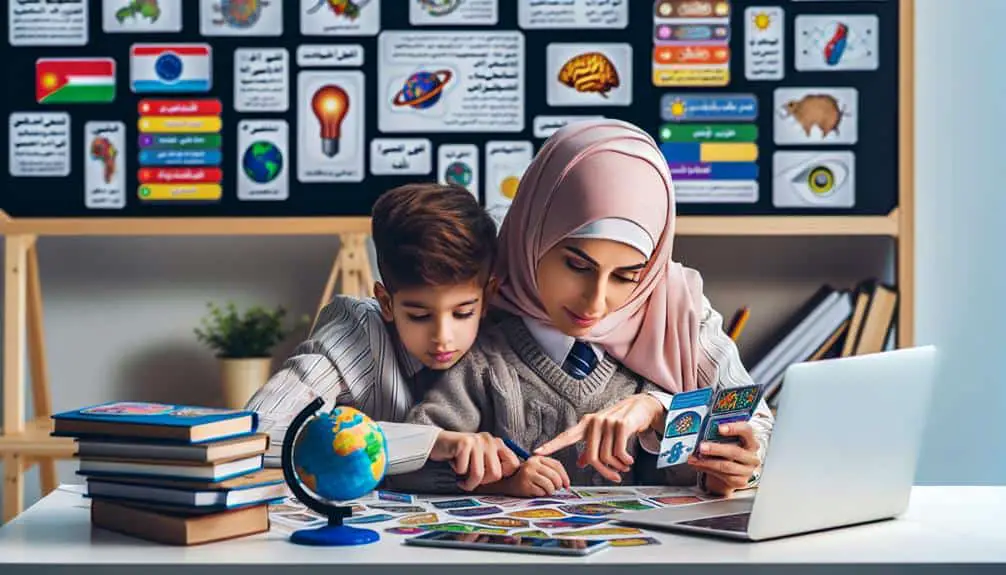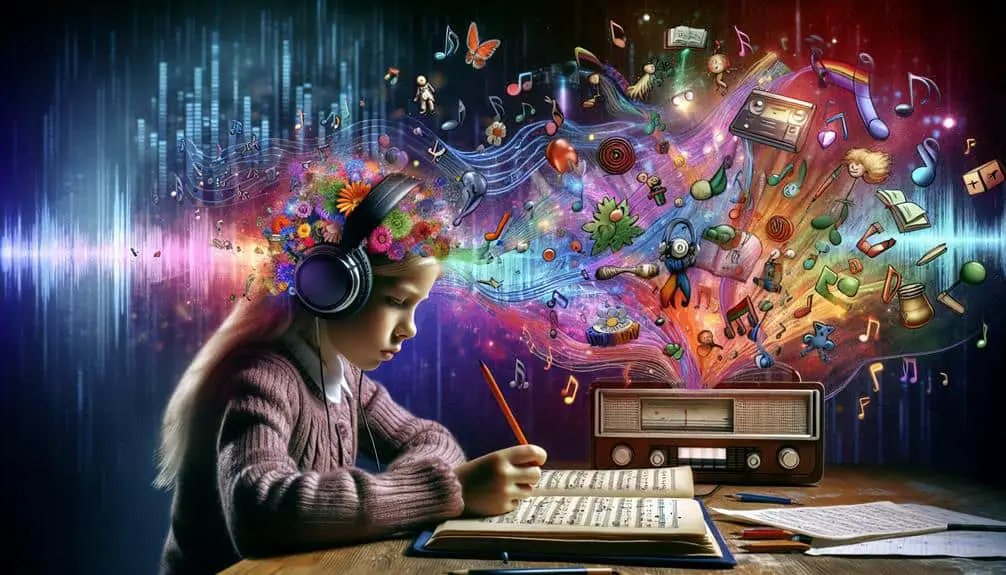When tailoring your homeschool instruction to learning styles, remember to cater to auditory, visual, kinesthetic, and reading/writing preferences. Auditory learners thrive with discussions and audio resources like podcasts. Visual learners benefit from charts, videos, and visual aids like graphs. Kinesthetic learners excel with hands-on activities and physical engagement. Multimodal learners appreciate varied teaching methods. To create effective and personalized learning experiences, adapt instruction to suit individual preferences and strengths. By understanding and accommodating diverse learning styles, you can guarantee a more engaging and successful homeschool environment. More insights await on addressing specific learning style preferences in homeschooling.
Key Points
- Customize teaching methods for auditory, visual, kinesthetic, and reading/writing learners.
- Incorporate auditory resources, discussions, and verbal instructions for auditory learners.
- Use visual aids like graphs, charts, and videos for visual learners.
- Engage kinesthetic learners with hands-on activities, experiments, and physical engagement.
- Adapt instruction for multimodal learners by incorporating varied materials and flexible assessment methods.
Understanding Learning Style Preferences
To effectively tailor homeschool instruction to individual students, it's essential to understand their specific learning style preferences. Learning preferences play a vital role in determining the most effective homeschooling styles for each student. By identifying whether a child is an auditory, visual, kinesthetic, or reading/writing learner, parents can customize their teaching methods to suit their child's individualized instruction needs.
Educational approaches vary depending on the learning style preferences of the student. For auditory learners, incorporating discussions, audiobooks, and verbal instructions can enhance their understanding of the material. Visual learners benefit from visual aids, such as graphs, charts, and videos, to grasp concepts better. Kinesthetic learners thrive when given hands-on activities and opportunities to engage physically with the subject matter. Reading/writing learners excel with written materials, textbooks, and note-taking strategies.
Identifying Visual Learners in Homeschooling
Identifying visual learners in homeschooling involves recognizing specific behaviors and preferences that indicate a strong reliance on visual stimuli for effective learning. Visual learners often prefer information presented in the form of charts, diagrams, maps, and videos. They may have a keen eye for detail, enjoy art and colors, and tend to remember information better when it's visually displayed. In a homeschool setting, visual learners thrive when provided with visual aids such as educational posters, infographics, and interactive whiteboards.
Hands-on activities are also beneficial for visual learners as they engage kinesthetic learning alongside visual input. Building models, conducting experiments, and using manipulatives can enhance their understanding of complex concepts. When teaching visual learners at home, incorporating plenty of visual cues, color-coding information, and utilizing technology for interactive learning experiences can significantly improve their comprehension and retention.
Catering to Auditory Learners at Home
In homeschooling, enhancing the learning experience for auditory learners involves integrating instructional methods that prioritize auditory information processing. Auditory learners thrive in environments where they can listen, discuss, and engage with content through sound.
To cater to auditory learners at home, consider the following:
- Utilize Audio Resources: Incorporate podcasts, audiobooks, and online lectures to provide auditory learners with information in a format that aligns with their learning style.
- Facilitate Interactive Discussions: Encourage verbal participation in discussions, debates, and question-and-answer sessions to stimulate auditory learners' engagement and comprehension.
- Integrate Creative Music: Use music as a mnemonic device to help auditory learners remember information more effectively.
- Employ Storytelling Techniques: Narrate lessons, create audio stories, or use storytelling as a means to convey concepts in a captivating and memorable way.
Strategies for Kinesthetic Learners in Homeschool
When homeschooling kinesthetic learners, incorporating hands-on activities into your daily lessons can greatly enhance their learning experience and retention of information. Kinesthetic learners thrive on movement and tactile experiences, so consider activities where they can physically engage with the material. Utilize resources like manipulatives, educational games, and experiments to make learning interactive and engaging.
Essential breaks are essential for kinesthetic learners to release pent-up energy and refocus. Incorporate short breaks between lessons for stretching, quick exercises, or even a short walk. These breaks can help improve concentration and overall learning outcomes.
Another effective strategy for kinesthetic learners is to integrate real-life experiences into lessons. Field trips, nature walks, or even simple tasks like cooking can provide hands-on learning opportunities that cater to their learning style.
Incorporating hands-on activities not only helps kinesthetic learners better understand concepts but also makes learning more enjoyable and memorable for them. By adapting your homeschool instruction to include movement breaks and interactive experiences, you can create a stimulating environment that supports their unique learning needs.
Adapting Instruction for Multimodal Learners
To effectively cater to multimodal learners, consider incorporating a variety of instructional methods that appeal to different learning preferences and styles. Multimodal learners benefit from a diverse range of approaches that engage their various senses and learning pathways. When adapting instruction for these learners, it's essential to implement strategies that promote understanding and retention through a personalized and flexible approach.
- Multisensory activities: Engage learners through activities that involve multiple senses, such as hands-on experiments, visual aids, auditory cues, and interactive projects.
- Individualized approach: Tailor lessons to meet the unique strengths and preferences of each learner, providing choice in how they demonstrate their understanding.
- Varied instructional materials: Utilize a mix of textbooks, online resources, videos, and manipulatives to accommodate different learning styles.
- Flexible assessment methods: Allow for alternative forms of assessment, such as presentations, portfolios, or hands-on demonstrations, to accurately evaluate comprehension and mastery.




